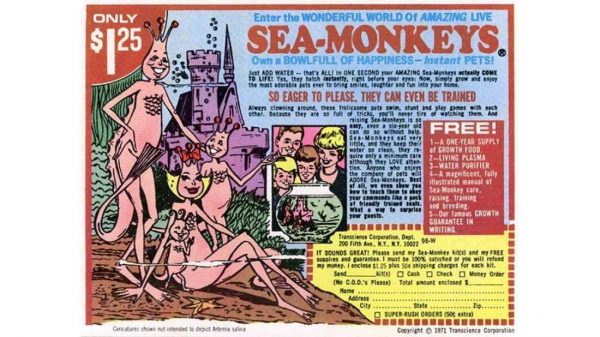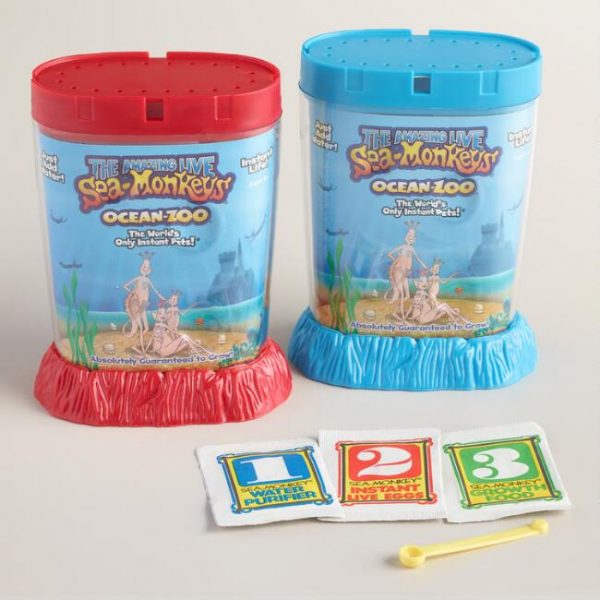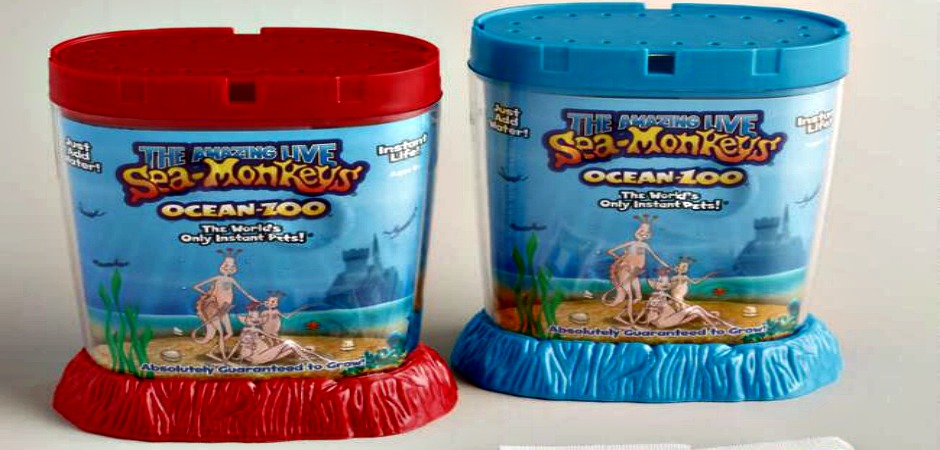Many people may remember their first realization that things may not in reality always be as they are portrayed. Some people probably learned this from their experience with Sea Monkeys.
Imagine it, you have been reading your latest issue of The Flash (The Fastest Man Alive!) comic book when you come across an ad. It shows a royal family of sea creatures, each with two feet that end in flippers, an eel-like tail, two arms with slender fingers and a thumb, and crowns on their heads. The mom-looking one is also somewhat sexy-looking, with her legs crossed, and a knowing smile on her face as she side-eyes you seductively.
“Enter the WONDERFUL WORLD Of AMAZING LIVE SEA-MONKEYS!” it proclaims. (seriously, I have one of the ads in an old comic book, that is the font and capitalization.)
For the low price of $1.25, you are promised instant pets that will hatch in one second when water is added, and who are “SO EAGER TO PLEASE, THEY CAN EVEN BE TRAINED!”
So you cut out the coupon, filled it out and placed it and one of your birthday dollars and two dimes and a nickel you found by combing through the couch cushions into an envelope you asked your mom for. Then you addressed it to the company in New York City, where all things from ads in comic books originate, and then went back down to ask your mom for a stamp. Eventually, she found one in her purse of all possible things you might want, and you took it out to the mailbox.

Vintage Sea Monkey Ad (x)
And then you waited.
And waited. And waited some more.
Finally, an envelope came in the mail with an instruction guide filled with more of the same fanciful claims of vitamins, and sea monkey toys, and the fact that these were not monkeys, but Brine Shrimp. This was but one of the things that you found out by reading the book; another was that you weren’t going to see them in one second, you actually had to add the nutrient packet to the water, wait 24 hours, and then add the packet of eggs. The various powders and nutrient packets all formed a sort of sludgy mess in the bowl you had taken from the cupboard and not told your mom.
Eventually, tiny little whirring motions could be seen, and the sludge filtered to the bottom, and you got out your magnifying glass to see some weirdly lice-like creatures swimming around. It was definitely not as advertised, but it was kind of cool, nonetheless. They were impossibly small and in more or less constant motion until they later died, but they were fun to look at, and the bowl really didn’t smell that bad after all. They weren’t going to form cities and governments, and have spirited debates about the utility of the monarchy in this modern age of the new bowl in which they lived, but they were interesting and they were something you had raised yourself from eggs. They were also pretty low maintenance because you were never going to order any of the accessories in the instruction book, so they were just going to swim around for a while and then eventually die. Much like the ants in the ant farm you had gotten, in which as the ants died, the remaining ants piled their bodies in the corner until there was a huge pile of dead ants in one spot, and then one lone ant who had died before making it back to the pile.
Still kind of fun.

Modern Sea Monkey Kit (x)
The actual genesis of this product was that in 1957, Harold von Braunhut saw a species of brine shrimp, Artemia salina, being sold as pet food in a pet store. In nature, they live in salt lakes or salt flats, and when the water evaporates, they go into a state of suspended animation known as cryptobiosis. They form a cocoon like casing, which dissolves when the water returns. Von Braunhut, with the help of a marine biologist, figured out a way to treat tap water with a mix of nutrients to revive the shrimp in your home.

Sea Monkies In Aquarium (x)
Von Braunhut, said in an interview with the Baltimore Sun in 1997: “I thought, if you could take a package of powder and put it in water and see it come to life. What could be more remarkable than that? … I was always interested in wildlife, and I was looking for something that would interest other people in it.” At first, with all the exorbitant claims (like the tricks, which are basically that they will swim towards light, and sometimes a finger placed against the tank,) he had a problem with their short life spans, which were a month at the outside. But then he ended up cross breeding the shrimp with another species, and changing the powders to increase health, life span, and vigor. This eugenics may have been something that appealed to the inventor, who also had a disturbing connection to white supremacy, which was very odd, considering his Jewish ancestry.
But it is definitely a tribute to the man’s utter lack of concern that his advertising promises were totally overblown; among other things, he made us believe in the Sea Monkey kingdom, the ability of X-Ray Specs to allow us to see our bones by putting on plastic glasses with a feather inside its paper lenses, (and which was also advertised in the same comic books, sometimes with a guy wearing them and presumably seeing through a girl’s clothes in the distance, from the expression on his face as he gazed at her,) and about 200 other patents he had created. He was also the guy who invented doll eyes that roll open and closed when the doll was tilted, and some defense tools that police still use to this day.
His most impressive product for sheer brazenness was “Invisible Goldfish.” These came with a glass bowl, a handbook, and fish food. That was it.
Apparently they sold the entire run, because with a 100 percent guarantee that the buyer would never see the fish, it never failed to succeed.
So, I guess the moral of the story is that it takes a weird guy to sell a weird product, and that kids can find fun with even a murky bowl of tiny whirring things. It was life, after all, and you created it by throwing some powder into water and watching it turn into something. You learned an odd group of lessons from it, and hey, what else do you want for $1.25?






Tentacle Tuesday: Spring Has Sprung… Its Snare! – Who's Out There?
[…] Remember these? For those wondering what they looked like in reality (how many of us actually ordered them?), take a gander at Sea Monkeys: False Advertising of Science Can Still Be Fascinating! […]